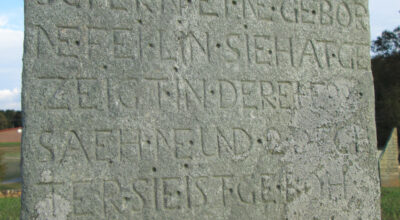Tetzel’s true trilobite
Published 12:00 am Monday, September 8, 2014
I grew up loving fossils, but there were none weathering out of the banks of the ditches along the Old Concord Road. I had to be content with pictures in books and a piece of petrified wood which my scoutmaster uncle Ross Garrison found in the Uwharrie Mountains.
Then came the time when my sixth-grade Granite Quarry School teacher, Mrs. Roselyn Misenheimer, took our class to the Charlotte Nature Museum in 1964, almost one generation’s worth of time before Discovery Place opened.
My mother had given me that most prized possession of all to be carried along on a grade school field trip, “Gift shop money,” so I put it to proper use! I still have those “first fossils” in my collection: shark tooth, crinoid stem, fern leaves, dinosaur bone (a little one) and trilobite.
Trilobites lived in the oceans many millions (actually, mega-millions) of years ago. They kind of resembled horseshoe crabs or pill bugs, in that some could curl up. They had just as many physical variations as the dinosaurs, but compared to those great forever-battling reptiles of film (where their only battling still occurs), trilobites don’t lend themselves to Hollywood.
Even if the largest trilobite (a little over 2 feet) were to somehow miraculously crawl out of extinction onto Tokyo Beach today, that city would have nothing to fear. The greatest threat from this spiny creature would be to a beach-walker who had forgotten his flip-flops!
The trilobite occupied a lowly place in life as a bottom-feeding, ocean-detritus scavenger, on a direct line of evolution to the catfish, the vulture and the present-day lawyer, not so much a close genetic link, but a similarity of “modus operandi” ( the shark is omitted due to relative nobility in comparison to that bunch).
Some scientists say trilobites were the first creatures to see the light of day, but in the “murk” where they lived, being blind like the fish in Linville Caverns would have made more sense.
I took to carrying some of my fossils around in my dungaree pocket, especially my trilobite. Some people carry “worry stones” to have something for their fingers to “worry with,” as aids for nervousness.
My trilobite probably relieved some childhood nervousness or minor worries; though probably not making make me any less “worrisome.”
Sometimes carrying several fossils, I had a mini, natural history “pocket-museum” in my pants which spanned the ages ( or at least a few of them). I felt “buttressed” by those eons (“buttressing” from side, not rear pocket).
One day, at Saint Paul’s Lutheran ( most likely a Sunday, or Vacation Bible School day), I showed Pastor Floyd W. Bost my most favorite fossil, my trilobite.
I proudly proclaimed: “This is a 600-million-year- old fossil trilobite!”
Pastor Bost said it kind of reminded him of the days when the Church in Rome sponsored the selling of Holy Relics and indulgences (sins expurged through money), leading to Martin Luther’s beginning of the Protestant Reformation .
I felt somewhat deflated, but my trilobite remained its same, ages-old size ( U.S. 25 cent piece).
One prominent purveyor of what Pastor Bost spoke was Johann Tetzel, in early 1500s Germany.
Tetzel was a thorn in Luther’s side, as was, of course, the devil. While translating the Bible into German at the Wartburg Castle, Luther looked up and saw the devil’s image on the wall smiling at him. He threw his inkwell at that infamous face, and it is said that the ink stain on the wall can be seen to this day.
As far as holy relics are concerned, it’s been said that if all of the “true finger bones of St. John” and “splinters of the true cross” were each a “true” one, they would cumulatively equal several thousand fingers and a forest of trees, respectively. Though not very Lutheran of me, I like to think that said saint is truly represented by at least a couple of knuckles in that lot of bony digits.
Pastor Bost grinned widely (an endearing, enduring, lifelong trait), and I knew that this highly intelligent man wasn’t trying to start some fight with science. ( I’m sure he knows that science and religion can co-exist.) He was just “picking” with me and trying to teach me of those earlier times by displaying the Luther-like skepticism that sparked the Protestant Reformation in 1517.
I knew and appreciated where Pastor Bost was coming from, and made no attempt at pressing a point.
Besides, I didn’t want to have to duck a hurled inkwell!


